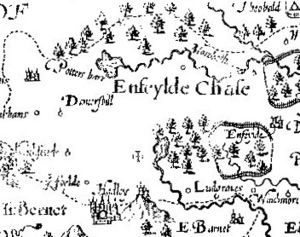Enfield Old Park facts for kids

Enfield Old Park was a very old deer park located in Enfield. It was a special place where deer and other animals lived. This park is even mentioned in the Domesday Book, a famous survey from 1086.
The Domesday Book only mentions one other park in Middlesex (the old county where Enfield is). This makes Enfield Old Park a very rare and important historical site. Today, some parts of the Old Park have houses built on them, in an area called Grange Park. But many large areas are still open and undeveloped.
Contents
A Look at Early History
Ancient Fort and Early Records
The park was built around an Iron Age hill fort. A hill fort is an old type of fort built on a hill. You can still see parts of this ancient fort near the Old Park House, which is now part of the Bush Hill Golf Club. These are the biggest remains of a hill fort in the old county of Middlesex.
The Domesday Book from 1086 recorded that the land of Enfield was owned by Geoffrey de Mandeville. It also clearly stated: 'there is a park there'. This means the park was used to keep wild animals for hunting. It stayed that way until the 1700s.
It's possible the area was already a game park even before the Norman Conquest in 1066. This is because the land was owned by Asgar, who looked after the animals for Edward the Confessor, an Anglo-Saxon king. A map made by John Norden around 1593 clearly shows the Old Park fenced in, with Salmons Brook flowing through it.
The Park Ranger's Home
Near Salmon's Brook, inside the Enfield Golf Course, you can find the remains of a moated house. A moated house is a building surrounded by a ditch filled with water. Experts believe this was the home of the Park Ranger. The ranger was the person who looked after the park and its animals. Having this moated site connected to a medieval deer park makes it even more important historically.
Royal Connections to Enfield Old Park
The Inner Park and Royal Visits
In the mediaeval period, documents called the park 'Parcus Intrinsicus'. This is Latin for 'the Inner Park'. This name helped tell it apart from the much larger Enfield Chase, which was not fenced in. The name 'Old Park' started to be used around the 1400s. Around this time, the park and the land of Enfield became property of the royal family, as part of the Duchy of Lancaster.
Queen Elizabeth I often came to Enfield for hunting. She sometimes stayed at the Manor House, known as 'Enfield Palace', which was at the edge of the park. She also stayed at Enfield House (Elsyng Palace). In 1596, a man named Robert Carey, 1st Earl of Monmouth wrote that "The Queen came to dinner at Enfield House and had toils [traps] set up in the park to shoot the bucks after dinner." This shows how much she enjoyed hunting there.
New River and Deer Count
In the early 1600s, the New River was built. This river was made to bring fresh water to London. Part of its path went through Enfield Old Park. In April 1620, a count of the animals in the park showed there were 207 fallow deer. Out of these, 73 were "Deare of Anteleir," meaning male deer with antlers.
The Park During the Commonwealth
During the time of the Commonwealth, when Oliver Cromwell was in charge, the park was taken over by the government. A detailed survey was done. This survey said the park was about 553 acres (or 2.2 square kilometers). It was valued at £311 and 10 shillings. The survey also mentioned that the park had rabbits and "50 sorts of several deer."
The park was first given to soldiers who hadn't been paid. Later, it was given to George Monck, 1st Duke of Albemarle.
Changes Over Time
Enclosure and New Roads
After the English Restoration, when the monarchy returned, the park stayed with Monck's family. They started selling off parts of it. A big change happened because of the 1777 Enclosure Act. This law divided up Enfield Chase among different owners, including Samuel Clayton, who owned the park at the time. This meant new roads and gates had to be built, including the road we now know as Green Dragon Lane.
Over the next 100 years, much of the land changed hands. Even though the area was mostly farmland, building started in many parts of the Old Park Estate. In 1893 and 1895, two golf clubs, Enfield Golf Club and Bush Hill Golf Club, rented large parts of the Old Park. They are still there today.
Modern Development and Remaining Green Spaces
When the railway came to the area, the land became very valuable for building homes. Both Grange Park station and Enfield Chase station are located within what used to be the Old Park. Between 1910 and 1936, most of the area we now call Grange Park was built.
The name of the park is still remembered in several road names, like Old Park Ridings, Old Park Road, and Old Park Avenue. Today, Enfield Town Park and Cheyne Walk Open Space are the only parts of the Old Park that are still open to the public as green spaces.

